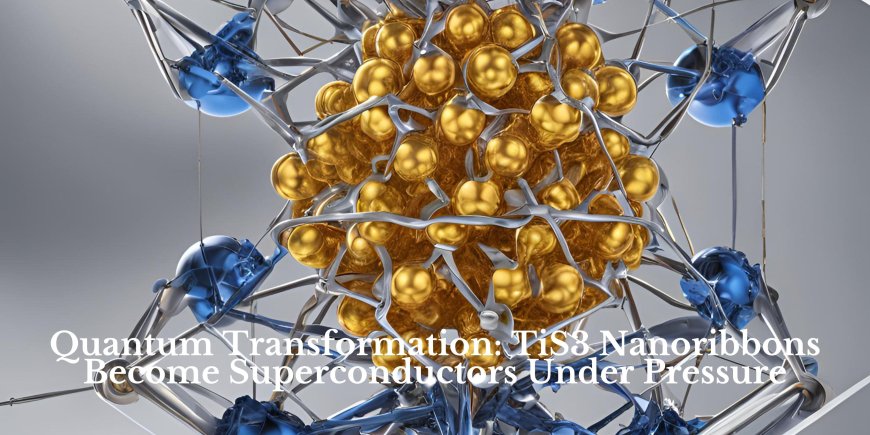Quantum Transformation: TiS3 Nanoribbons Become Superconductors Under Pressure
Researchers have discovered that TiS3 nanoribbons exhibit superconductivity under pressure, a breakthrough with significant implications for quantum computing and advanced technologies. Learn how this discovery could revolutionize various scientific fields.

Quantum Transformation: TiS3 Nanoribbons Become Superconductors Under Pressure
In a landmark discovery, researchers have found that TiS3 (titanium trisulfide) nanoribbons can become superconductors when subjected to pressure. This groundbreaking finding holds immense potential for the future of quantum computing and various advanced technologies, marking a significant leap in our understanding of nanomaterials and their applications.
The Discovery
The journey towards this discovery was rooted in the exploration of unique properties exhibited by low-dimensional materials. TiS3 nanoribbons, known for their quasi-one-dimensional structure, have been of particular interest due to their distinctive electrical and optical properties. However, the transformation of these materials into superconductors under pressure is a revelation that has caught the scientific community's attention.
Understanding Superconductivity
Superconductivity is a state in which a material can conduct electricity without resistance, often resulting in zero energy loss. This phenomenon, typically observed at extremely low temperatures, can revolutionize energy transmission, magnetic resonance imaging (MRI), and quantum computing. The ability to induce superconductivity in materials at higher, more practical temperatures and conditions has been a long-standing goal in materials science and condensed matter physics.
Mechanism of Transformation
The researchers subjected TiS3 nanoribbons to varying degrees of pressure and meticulously observed their electronic properties. It was discovered that under high pressure, the atomic structure of TiS3 undergoes significant changes, leading to the emergence of superconductivity. This transformation is attributed to the alteration in the electronic band structure and the enhancement of electron-phonon interactions, which are crucial for the onset of superconductivity.
Experimental Methods
The study utilized advanced techniques such as high-pressure diamond anvil cells, Raman spectroscopy, and electrical transport measurements. High-pressure diamond anvil cells allowed the researchers to apply controlled pressure to the nanoribbons while monitoring their structural and electronic changes. Raman spectroscopy provided insights into the vibrational modes of the material, confirming the structural transitions, while electrical transport measurements demonstrated the zero-resistance state indicative of superconductivity.
Implications for Quantum Computing
The discovery of pressure-induced superconductivity in TiS3 nanoribbons holds profound implications for quantum computing. Superconductors are integral to the development of qubits, the fundamental units of quantum computers. The unique properties of TiS3 nanoribbons, combined with their ability to become superconducting under accessible conditions, could pave the way for more stable and scalable quantum computers.
Quantum computers leverage the principles of quantum mechanics to perform computations far more efficiently than classical computers. Superconducting qubits, formed by superconductors like TiS3 under pressure, can maintain quantum coherence for extended periods, essential for practical quantum computing. This breakthrough could thus lead to more robust quantum computers capable of solving complex problems in cryptography, material science, and artificial intelligence.
Advanced Technologies and Applications
Beyond quantum computing, the superconducting properties of TiS3 nanoribbons can revolutionize various advanced technologies:
-
Energy Transmission: Superconductors can transmit electricity with zero energy loss, potentially leading to more efficient power grids and reduced energy consumption. The use of TiS3 nanoribbons in superconducting cables could enhance the efficiency and sustainability of energy systems.
-
Magnetic Resonance Imaging (MRI): Superconducting magnets are crucial for high-resolution MRI machines. The development of TiS3-based superconductors could lead to more powerful and efficient MRI systems, improving medical diagnostics and treatment.
-
Particle Accelerators: Superconductors are used in particle accelerators to generate strong magnetic fields necessary for accelerating particles to high speeds. TiS3 nanoribbons could enhance the performance and efficiency of these accelerators, contributing to advancements in particle physics.
-
Electronics and Sensors: The unique electrical properties of TiS3 nanoribbons, combined with their superconducting capabilities, can lead to the development of advanced electronic devices and sensors with higher sensitivity and performance.
Future Research Directions
The discovery of superconductivity in TiS3 nanoribbons under pressure opens up numerous avenues for future research:
-
Material Optimization: Further studies can focus on optimizing the composition and structure of TiS3 nanoribbons to enhance their superconducting properties and transition temperatures.
-
Temperature Variability: Research can explore the behavior of TiS3 nanoribbons under varying temperature conditions to identify the optimal range for superconductivity, aiming for higher operational temperatures.
-
Integration with Other Materials: Combining TiS3 nanoribbons with other superconducting and non-superconducting materials could lead to the development of hybrid systems with tailored properties for specific applications.
-
Theoretical Modeling: Advanced theoretical models can be developed to better understand the mechanisms underlying pressure-induced superconductivity in TiS3 nanoribbons, guiding experimental efforts and material design.
-
Scaling and Fabrication: Research into scalable fabrication methods for TiS3 nanoribbons will be crucial for their practical application in industrial and technological settings.
Conclusion
The discovery that TiS3 nanoribbons can become superconductors under pressure is a monumental step forward in materials science and condensed matter physics. This breakthrough not only enhances our understanding of low-dimensional materials but also holds transformative potential for quantum computing and various advanced technologies. As research continues to unravel the mysteries of this unique phenomenon, the future of superconductors looks brighter than ever, promising a new era of innovation and technological advancement.

 LD Web Desk
LD Web Desk 